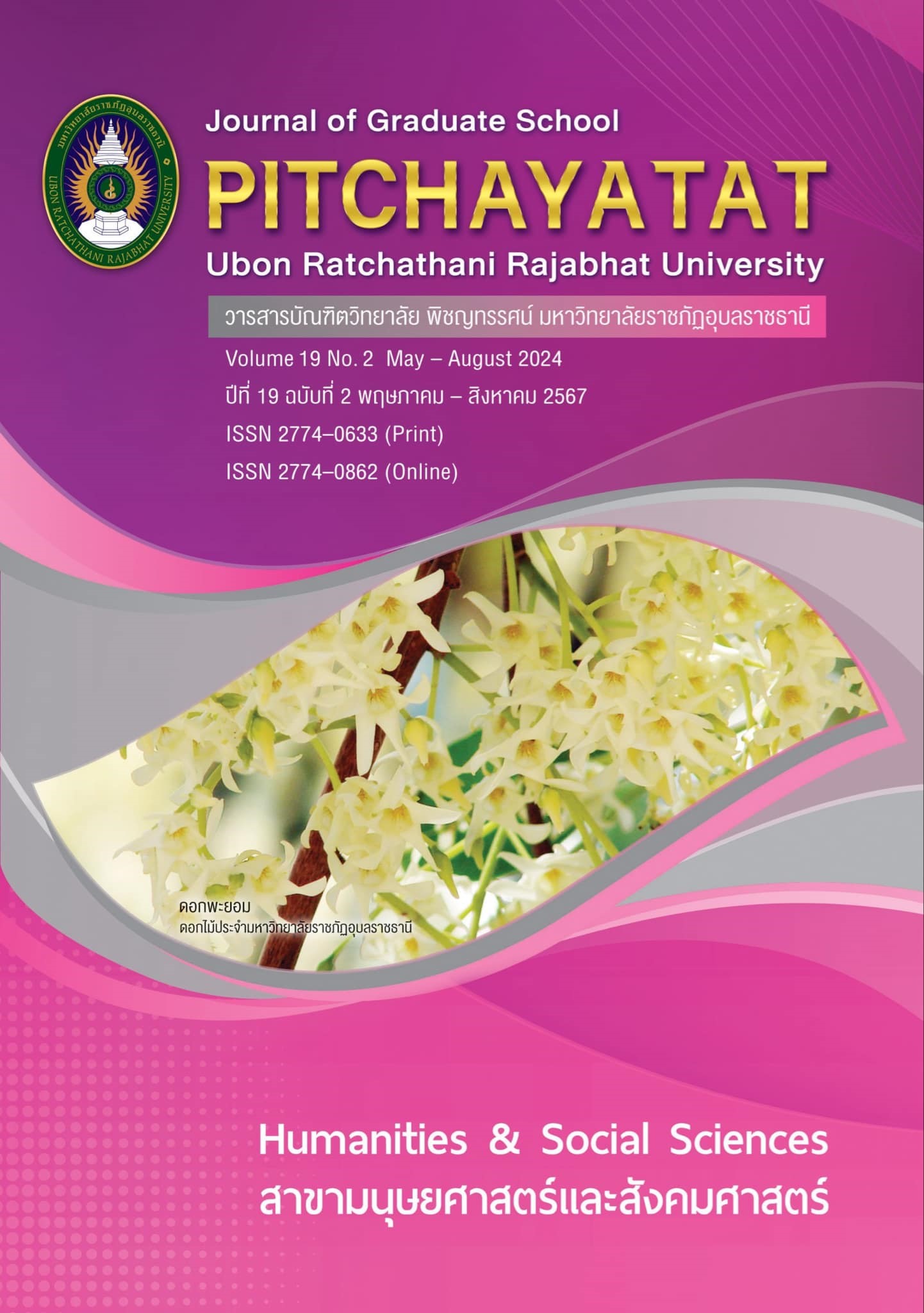นวัตกรรมการพัฒนาระบบและกลไกการจัดการเพื่อเสริมสร้างความเข้มแข็งของชุมชน ในการพัฒนาเศรษฐกิจฐานรากบนฐานทุนทางสังคม สู่การแก้ไขปัญหาความยากจนแบบเบ็ดเสร็จ และยั่งยืน กรณีศึกษาบ้านไทรงาม ตำบลนาเสียว อำเภอเมือง จังหวัดชัยภูมิ
คำสำคัญ:
ทุนทางสังคม , ระบบและกลไก , ความยากจน , ความเข้มแข็งของชุมชนบทคัดย่อ
การวิจัยนี้มีวัตถุประสงค์เพื่อ 1) ศึกษาสถานการณ์ความยากจนเชิงพื้นที่บ้านไทรงาม ตำบลนาเสียว อำเภอเมือง จังหวัดชัยภูมิ 2) ศึกษาการเสริมสร้างความเข้มแข็งของชุมชนโดยใช้ทุนทางสังคมเป็นฐานในการแก้ไขปัญหาความยากจน 3) เพื่อให้เกิดนวัตกรรมการพัฒนาระบบและกลไกการจัดการเพื่อเสริมสร้างความเข้มแข็งของชุมชนในการแก้ไขปัญหาความยากจน ตัวอย่าง ได้แก่ ผู้นำชุมชน ประชาชนชาวบ้านไทรงาม กลุ่มวิสาหกิจ ตัวแทนองค์การบริหารส่วนตำบลเสียว รวม 109 คน โดยใช้ระเบียบวิธีวิจัยเชิงคุณภาพ
ผลการวิจัยพบว่า
- ประชาชนในชุมชนมีฐานะยากจนเกิดภาระหนี้สิน แหล่งน้ำเพื่อการเกษตรไม่เพียงพอต่อการทำการเกษตร ค่าครองชีพสูงขึ้น ต้นทุนในการประกอบอาชีพเกษตรที่สูงขึ้น มีที่ดินทำกินน้อย การเข้าถึงสวัสดิการของรัฐ การศึกษา และสุขภาพ ปัญหาความยากจนสามารถแบ่งออกได้เป็น 3 ลักษณะ คือ ปัญหาที่ชาวบ้านสามารถจัดการได้เอง ปัญหาที่ชาวบ้านไม่สามารถจัดการได้ และปัญหาที่ชาวบ้านและหน่วยงานภายนอกร่วมกันบริหารจัดการไปพร้อม ๆ กัน
- การเสริมสร้างความเข้มแข็งของชุมชนโดยใช้ทุนทางสังคมได้แก่ 1) ทุนมนุษย์ คือ ผู้นำชุมชน ผู้นำกลุ่ม สมาชิกกลุ่ม ปราชญ์ชาวบ้าน ที่มีองค์ความรู้ ความรอบรู้ ทักษะ ความชำนาญ ภูมิปัญญา ด้านเกษตร ด้านสมุนไพร ด้านดิน ด้านปุ๋ยอินทรีย์ 2) ทุนทางสังคม คือ คนในชุมชนมีวิถีชีวิตแบบถ้อยทีถ้อยอาศัยกันรู้จักกันทุกหลังคาเรือน มีความสัมพันธ์กันแบบระบบเครือญาติ มีความไว้วางใจซึ่งกันและกัน มีความรักความสามัคคีแน่นแฟ้นเป็นปึกแผ่น และเป็นพลังหนุนเสริมในการขับเคลื่อนกระบวนการเรียนรู้ต่าง ๆ ของสมาชิกในชุมชน 3) ทุนกายภาพ คือ โรงสีชุมชน กลุ่มผลิตปุ๋ยอินทรีย์ ซึ่งมีความเชื่อมโยงไปยังกลุ่มอาชีพภายในชุมชน เช่น กลุ่มสมุนไพร กลุ่มนาแปลงใหญ่ กลุ่มโคเนื้อ 4) ทุนธรรมชาติ คือ ลำห้วยบง ป่าชุมชน (ป่าสำแก) มีเนื้อที่ประมาณ 30 ไร่ เป็นแหล่งอาหารตามธรรมชาติตามฤดูกาล 5) ทุนทางเศรษฐกิจ คือ กองทุนหมู่บ้าน กลุ่มออมทรัพย์เพื่อการผลิต กลุ่มสตรี กองทุนแม่ของแผ่นดิน กลุ่มสัจจะออมทรัพย์ กองทุนเงินกระตุ้นเศรษฐกิจ และกลุ่มออมทรัพย์ของชุมชน และ 6) ทุนวัฒนธรรมและภูมิปัญญา คือ ประเพณีวัฒนธรรมที่หล่อหล่อมให้คนในชุมชนเกิดความสามัคคีกลมเกลียว และภูมิปัญญาความรู้ความเชี่ยวชาญในการรักษาด้วยสมุนไพร
- นวัตกรรมการพัฒนาระบบและกลไกการจัดการเพื่อเสริมสร้างความเข้มแข็งของชุมชนในการแก้ไขปัญหาความยากจนแบบเบ็ดเสร็จและยั่งยืน คือ การนำทุนทางสังคมมาประยุกต์ใช้แก้ไขปัญหาความยากจน โดยผ่านกระบวนการมีส่วนร่วมในทุกขั้นตอนของการดำเนินงานต่าง ๆ ที่มีความสัมพันธ์และเชื่อมโยงกันอย่างเป็นระบบตามกระบวนการพัฒนาคุณภาพ PDCA ประกอบด้วยกระบวนการวางแผน (Plan) การปฏิบัติตามแผน (Do) การตรวจสอบ (Check) และการปรับปรุงการดำเนินการอย่างเหมาะสมหรือการจัดทำมาตรฐานใหม่เป็นการยกระดับคุณภาพ (Act) ผ่านศักยภาพของชุมชน ด้านผู้นำ ด้านกระบวนการเรียนรู้ ด้านการบริหารจัดการ ด้านการปรับประยุกต์/การนำมาใช้ และด้านการประสานงานเครือข่ายความร่วมมือ โดยมีทุนทางสังคมเป็นฐาน
เอกสารอ้างอิง
กาญจนา แก้วเทพ. การพึ่งตนเอง: ศักยภาพในการพัฒนาชนบท. กรุงเทพฯ: สภาคาทอลิกแห่งประเทศไทยเพื่อการพัฒนา, 2540.
ขนิษฐา คงรักเกียรติยศ. อัตราความยากจนของประเทศไทยเพิ่มสูงขึ้นท่ามกลางเศรษฐกิจที่ชะลอตัว. (ออนไลน์).
(อ้างเมื่อ 5 มีนาคม พ.ศ. 2563). จาก https://www.worldbank.org/th/news/press- release/2020/03/03/thailands-poverty-on-the-rise-amid-slowing-economic-growth
ขวัญนภา สุขคร และคณะ. กระบวนการสร้างคุณค่าจากทุนทางสังคมวัฒนธรรม สู่การพัฒนาบนความเข้มแข็งและยั่งยืนของชุมชน ตำบลผาปัง อำเภอแม่พริก จังหวัดลำปาง. กรุงเทพฯ: มหาวิทยาลัย สวนดุสิต, 2562.
ณดา จันทร์สม. ทุนทางสังคมกับการพัฒนาที่ยั่งยืน. (ออนไลน์). 2564 (อ้างเมื่อวันที่ 16 สิงหาคม 2566). จาก https://thaipublica.org/2022/11/nida-sustainable-move09/.
ณัฐชยา ผิวเงิน. บทบาททุนทางสังคมในการพัฒนาชุมชนบ้านปลาค้าว ตำบลปลาค้าว อำเภอเมือง จังหวัดอำนาจเจริญ. กรุงเทพฯ: มหาวิทยาลัยเกษตรศาสตร์, 2554.
ธนพล สราญจิตร์. “ปัญหาความยากจนในสังคมไทย,” วารสารมนุษยศาสตร์และสังคมศาสตร์ มหาวิทยาลัยอิสเทิร์นเอเชีย. 5, 2 (พฤษภาคม-สิงหาคม 2558): 11-21.
ธีระชัย โสมเกษตรินทร์. การบริหารงานโครงการสอนซ่อมเสริมโรงเรียนบ้านนาดีทุ่งเจริญ สำนักงานเขตพื้นที่การศึกษาอุบลราชธานี เขต 1. วิทยานิพนธ์ครุศาสตรมหาบัณฑิต มหาวิทยาลัยราชภัฏอุบลราชธานี, 2550.
ประเวศ วะสี. ประชาคมตำบล ยุทธศาสตร์เพื่อเศรษฐกิจพอเพียง ศีลธรรมและสุขภาพ. กรุงเทพฯ: มติชน, 2541.
ปัณณพงศ์ วงศ์คณาศรี. ทุนทางสังคมกับข้อเสนอเชิงนโยบายของการบูรณาการทุนทางสังคม เพื่อการพัฒาท้องถิ่น. (ออนไลน์). 2559 (อ้างเมื่อ 3 ธันวาคม 2562). จาก https:/www.tci-thaijo.org/index.php/cjwu/article/view/95384.
พระปลัดประพจน์ สุปภาโต และคณะ. “ทุนทางสังคมกับการพัฒนาชุมชนวัดสำโรง อำเภอนครชัยศรี จังหวัดนครปฐม,” วารสารสันติศึกษาปริทรรศน์ มจร. 8, 3 (พฤษภาคม-มิถุนายน 2563), 2564.
มาลี ศรีพรหม และคณะ. การแก้ไขปัญหาความยากจนแบบเบ็ดเสร็จและแม่นยำในจังหวัดสกลนคร. สกลนคร : มหาวิทยาลัยราชภัฏสกลนคร, 2565.
วันชัย ธรรมสัจการ. “ทุนชุมชนและศักยภาพในการจัดการตนเอง เพื่อการพัฒนาที่ยั่งยืนของชุมชนท้องถิ่น,”วารสารนาคบุตรปริทัศน์ มหาวิทยาลัยราชภัฏนครศรีธรรมราช. 14, 1 (มกราคม–เมษายน 2565): 22-32.
วิชชุดา วงศ์พานิชย์. การถ่ายทอดกระบวนการแก้ไขปัญหาความยากจนอย่างยั่งยืนจังหวัดศรีสะเกษ. ศรีสะเกษ: มหาวิทยาลัยราชภัฏศรีสะเกษ, 2561.
วิศปัตย์ ชัยช่วย. “การใช้LINE ของผู้สูงอายุ : การศึกษาเชิงปรากฎการณ์วิทยา,” Veridian E-Journal, Silpakorn University ฉบับภาษาไทย สาขามนุษยศาสตร์ สังคมศาสตร์ และศิลปะ. 10, 1 (มกราคม –เมษายน 2560): 905-918.
พัฒนาองค์กรชุมชน (องค์การมหาชน), สถาบัน. คู่มือส่งเสริมการพัฒนาระบบเศรษฐกิจฐานราก. กรุงเทพฯ: สถาบันพัฒนาองค์กรชุมชน (องค์การมหาชน), 2559.
สุริยะ หาญพิชัย และคณะ. “ยุทธศาสตร์ขจัดความยากจนของเกษตรกรในจังหวัดชัยภูมิ,” วารสารมนุษยศาสตร์และสังคมศาสตร์ มหาวิทยาลัยราชภัฏอุบลราชธานี. 10, 1 (มกราคม-มิถุนายน 2562): 319-330.
หน่วยงานบริหารและจัดการทุนด้านการพัฒนาระดับพื้นที่. อว.ร่วมกับ 12 หน่วยงาน : จับมือขับเคลื่อนพื้นที่ปฏิบัติการร่วมเพื่อการแก้ปัญหาความยากจนอย่างเบ็ดเสร็จและแม่นยำ. (ออนไลน์) 2564 (อ้างเมื่อ 10 สิงหาคม 2566). จาก https://pmua.or.th/455/fbclid=IwAR3m3PYDML7PyVfpz1sL9ynTvYMoKeWJbMWEziR559j_7CqmKNDADg4-3ho
อุทัย บุญประเสริฐ. การบริหารจัดการสถานศึกษาโดยใช้โรงเรียนเป็นฐาน School–Based Management. กรุงเทพฯ: โรงพิมพ์แห่งจุฬาลงกรณ์มหาวิทยาลัย, 2545.
Deming in Mycoted. Plan Do Check Act (PDCA) (Online) (2004). Available http://www.mycoted.com/creativity/techniques/pdca.php
ดาวน์โหลด
เผยแพร่แล้ว
รูปแบบการอ้างอิง
ฉบับ
ประเภทบทความ
สัญญาอนุญาต
ลิขสิทธิ์ (c) 2024 วารสารบัณฑิตวิทยาลัย พิชญทรรศน์ มหาวิทยาลัยราชภัฏอุบลราชธานี

อนุญาตภายใต้เงื่อนไข Creative Commons Attribution-NonCommercial-NoDerivatives 4.0 International License.
บทความทุกเรื่องได้รับการตรวจความถูกต้องทางวิชาการโดยผู้ทรงคุณวุฒิภายนอกอย่างน้อย 3 คน ความคิดเห็นในวารสารพิชญทรรศน์เป็นความคิดเห็นของผู้นิพนธ์มิใช่ความคิดเห็นของผู้จัดทำ จึงมิใช่ความรับผิดชอบของวารสารพิชญทรรศน์ และบทความในวารสารพิชญทรรศน์สงวนสิทธิ์ตามกฎหมายไทย การจะนำไปเผยแพร่ต้องได้รับอนุญาตเป็นลายลักษณ์อักษรจากกองบรรณาธิการ





